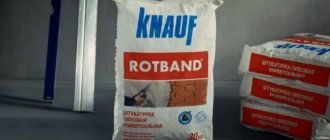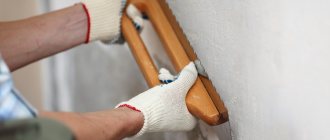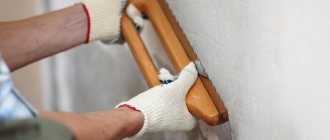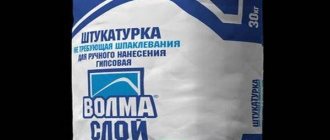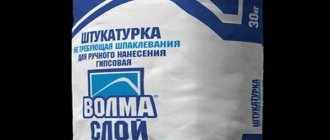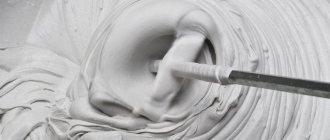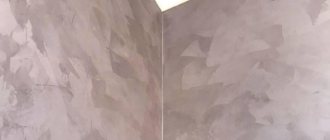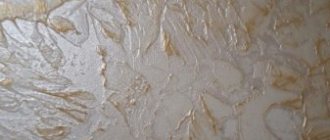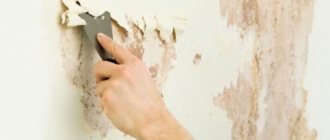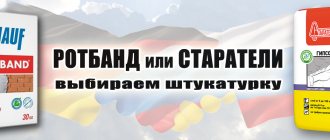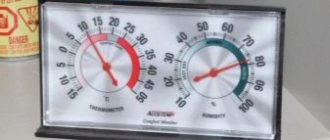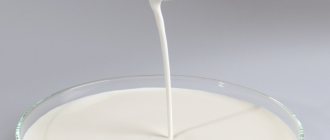Rotband plaster from the Knauf company is one of the most popular. During any renovation work in a room, you always have to plaster the surfaces afterwards so that they are even and smooth. To do this, you will need a special composition that contains cement, sand and lime. But Rotband, a universal gypsum plaster, will do instead; Knauf is the manufacturer of this product. If you use such material, the labor intensity of all plastering work will be noticeably reduced.
About plastering work and types of plaster mixtures
Surface plastering is a technological process in construction and repair aimed at leveling the surface, creating the correct geometry of the room and creating an intermediate protective layer between the finishing and the rough base. Also, a layer of plaster can serve as a technical layer for installing hidden wiring in houses where gating is prohibited.
By type, plaster mixtures are divided into:
- Cement;
- Calcareous;
- Plaster;
- Clay;
- Calcareous-clayey;
- Lime-gypsum;
- Lime-cement.
Rotband plaster belongs to the class of gypsum plasters for manual application.
Rotband 5 kg Bag 30 kg
What is Rotband?
| ← Repair dictionary wiki: back to word list | ||
- Knauf Rotband - what is it for?
- History of the creation of the mixture
- Knauf - company history
- How to breed - instructions
- Analogue of Rotband
- Consumption rate
- Goldband - difference
Those who do not decorate an apartment or dacha every day (and of course, the majority of them) often have a well-founded question about what “Rotband” is? In a conversation with the master (according to the reviews we collected - especially in Moscow), this mysterious word can be heard so often that a suspicion arises about its magical, almost occult, nature.
Why is Rotband needed?
In fact, “Rotband” is the trade name of a dry gypsum plaster mixture produced by enterprises of the Knauf group of companies. It is used for internal plastering of the surface of walls and ceilings, their leveling (see → interior decoration). In other words, “Rotband” is needed in order to make the ceiling and walls smooth, suitable for applying finishing - paint, wallpaper or tiles (the similar purpose of Rotband determines its technical characteristics specified in the instructions).
The word Rotband is translated from German as “red ribbon”. In addition to the “Red Tape” itself, Knauf produces or has previously produced “Grunband” (“green tape”; a cement-based plaster mixture), “Goldband” (“golden tape”), “Blauband” (“blue tape”). The founder of the company, Karl Knauf, once proposed designating mixtures in the manner of cigar bands, thus distinguishing individual brands. By the way, the cigar bands themselves were introduced into commercial circulation by Gustave Bock in 1854 at a time of growing cigar sales for purely marketing purposes, allowing one to clearly identify a particular manufacturer.
History of the Rotband brand
The first products from the Rotband family were produced in West Germany in 1962. Until this point, gypsum mixtures that were used during plastering work were compiled directly on site (at the construction site) without strictly following the recipe (by eye). The main obstacle to the industrial production of ready-made mixtures and their widespread distribution among craftsmen was the fact that gypsum tends to set quickly. It turned out to be possible to overcome this obstacle with the invention of a retardant additive, which was called “Alenal” after its inventor, Mr. Allen. It slowed down the setting process of the mixed mixture, allowing solutions to be mixed in larger quantities and applied more evenly.
Brief history of Knauf
The Knauf Gips KG company itself (until 2003 - Gebr. Knauf Westdeutsche Gipswerke) was founded in 1932 by the brothers Alfons and Karl Knauf (mining engineers). Initially, the factory was located on the banks of the Moselle in the German city of Perl, and the mine was located on the other side of the river in Luxembourg in a place called Schengen. The Knauf company commissioned its first gypsum stone mine in 1938 in a place called Stadtoldendorf (in 1972, the plant in this city began producing plasterboard sheets; Knauf has been producing gypsum boards themselves since 1958). After World War II, it was decided to move the head enterprise to the territory of the American occupation zone, to the city of Iphofen (Lower Franconia in Bavaria), where it is still located. Knauf is a family business that is still owned by members of the founding family. In Russia, Knauf's current activities began in 1993 with participation in the capital of the Thermal Insulation and Gypsum Products Plant (TIGI).
How to breed Rotband - instructions (video)
The mixture is quite environmentally friendly. The main binder, gypsum, participates in regulating the microclimate of the premises, if necessary absorbing excess moisture or releasing it. The mixture is mixed with water (for details on the technology and rules for diluting Rotband, see the instructions in the 2020 edition of the document or the video on how to apply). The resulting solution is easy to use when installing plastering systems. As a rule, it is applied in one layer, the maximum thickness of which is 30 mm. In order to calculate how long it takes for Rotband to dry, you need to click on the link and refer to the general rules for increasing the strength of plaster mortars. If we talk about how long it takes to putty the plaster, then this can be done after the specified drying period, the duration of which on average ensures the standard residual moisture content. When carrying out work on leveling surfaces in several layers, it is recommended to follow the “wet on wet” technology.
The mixture is packaged in paper bags of 5, 10 and 30 kg. You can most often find the latter in stores.
Products sold in Russia are manufactured at enterprises located in the CIS countries. In Moscow, these are, as a rule, products of the Krasnogorsk plant. In addition, on the market of the capital region there are mixtures manufactured at enterprises in St. Petersburg, the Krasnodar Territory or Balti (Moldova) - a list of Knauf enterprises in the CIS. The color of the mixture may differ depending on the characteristics of a particular batch of mineral used in the manufacture of the mixture at a particular plant (gray, pink, white, beige). According to the manufacturer's representatives, color does not affect the quality of the mixture in any way. However, there is a custom among craftsmen to consider, for example, “white” Rotband to be of lower quality (it has greater creep).
| Color | Manufacturer |
| pink | Chelyabinsk, Kolpino (St. Petersburg) |
| white | Kuban, Baskunchak |
| grey | Krasnogorsk (Moscow) |
Rotband analogues - how to replace the mixture and is it possible?
Let's start with the last question. Of course, it can be replaced. As a rule, this has to be done at the request of customers, when we are asked to help optimize the budget for repairs. But the first part of the question does not so easily reveal an affirmative answer.
Currently, there are a considerable number of Rotband analogues of similar quality on the market. Despite this, it still remains a favorite brand among the majority of finishing craftsmen in Russia.
Analogues of Rotband, among others, include such mixtures as (in alphabetical order):
- Vetonit base gyps;
- Volma layer;
- Founded Gipswell;
- Rusean Plaster;
- Prospectors gypsum;
- Gypsum standard.
The main problem in finding a worthy replacement is the stability of the product, maintaining standard properties regardless of the batch, time of year and supplier plant. It often happens that the old batch of some Russian analogue of Rotband, tested during one repair, did not differ at all from it, but now the new one deviates from the ideal.
Often, as an analogue, a mixture produced by Knauf is used for application using small-scale mechanization (machine) plaster. This mixture is called “Knauf MP 75”.
Rotband consumption per 1 m2
Determining this amount is quite simple. The consumption of the mixture per 1 m2 is 8.5 kg for a layer 10 mm thick (see also → consumption of finishing materials). The recommended thickness is 15 mm. This means that such a layer will require 12.75 kg. To be sure, this value should be increased by 10%. Total for plastering 1 sq. m will require 14 kg. Now we multiply this value by the area of work on the installation of plaster systems. We divide the resulting figure by 30 - it is advisable to buy the mixture packaged in 30 kg bags. As a result, we find out the number of bags. Of course, this is a reference calculation that does not take into account the condition of finishing surfaces or the geometry of the premises.
Now you don’t need to manually calculate the mixture - our special → Rotband consumption calculator is available to all website visitors!
In addition, this calculator offers the ability to simultaneously determine the required quantity and cost of analogue mixtures.
You can now find out information about how much Rotband costs in Moscow in an even more convenient form on a separate page using the link provided.
The difference between Rotband and Goldband
Although Goldband (translated into Russian: “golden ribbon”) is so widely represented on the market, the question often arises about which is better - Rotband or Goldband. The first contains adhesive components that provide reliable adhesion to the base. They are absent in Goldband. Therefore, in the designation of the Rotband mixture in German there is the word Haft-, haften (der Haftputz) - adhesion, adhere (adhesive plaster), and Goldband is referred to only as der Fertigputz - ready-made plaster mixture. Thus, Rotband is intended for application to both rough and smooth surfaces (for example, when plastering a ceiling). Goldband is used to level only rough surfaces that initially provide greater adhesion - brick, itong (a type of gas silicate), foam concrete blocks.
All data is provided without any guarantees or warranties.
Additional Information
We thank Knauf Gips KG (Iphofen) for their assistance in writing this article regarding the history of the brand and providing illustrative material.
Author: Attractive Repair Studio.
Links
There is currently no reference in the article on this topic.
Read
- Official information sheet indicating the characteristics and instructions for use of the Rotband mixture (Knauf); format - PDF.
- Brochure “The Rothband Family” published by Knauf in Russian as a PDF file.
- Several practical recommendations as an answer to the question of what is the best way to plaster walls in a new building.
Notes
No notes found for this article. We regularly edit dictionary entries. It is possible that additional materials will be posted at this location soon.
Where is Rotband used?
According to the technical documentation of the KNAUF company, namely, it is the manufacturer of Rotband in Russia, this plaster mixture can be used:
- Without a protective layer, only for interior work, in rooms with normal humidity;
- When protecting the plaster layer with tiles or other water-repellent material, in bathrooms and kitchens.
Simply put, if you decide to level and paint the wall, then you can use Rotband only in dry areas of the apartment. If you decide to level the wall and cover it with ceramic tiles or plastic, you can use Rotband everywhere.
Thanks to the polymers included in this mixture, it can be applied to the following surfaces of the walls and ceiling of the apartment:
- Concrete;
- Brick;
- Pre-plastered with cement mortar;
- DSP boards;
- Expanded polystyrene (!).
According to Rotband practice, plaster is applied to any durable surface coated with a primer such as concrete contact, including:
- On plasterboard for local leveling of differences in plasterboard surfaces;
- On ceramic tiles;
- On OSB, chipboard boards.
Rotband is NOT used for leveling floors. Can be used to seal cracks and holes in the floor for subsequent installation of screed or self-leveling floor.
Description of material
Rotband plaster mixture is dry gypsum plaster. It is based on high quality gypsum. It is diluted with special minerals. These fillers perform a binding function. Before mixing all the substances, they are crushed. Due to this, the contact area is increased, so that the adhesion to each other between the particles and the treated wall is higher.
Knauf plaster, like other products of this company, including the Rotband brand, is fully certified and meets all established quality standards. Are there other permitting documents? Other certificates are also available. For example, from the sanitary and epidemiological services, a document on the fire safety of the material. This indicates that Knauf gypsum plaster is completely safe for humans, so there is no risk to his health.
Rotband is a universal gypsum plaster. Before you start choosing a material, you need to decide on the shades, as there are several tones. For example, you can purchase a white composition called Knauf Gips Kuban. It is produced in the Astrakhan region and Krasnodar region. If you need Rotband 30 kg in a pink shade, then you can purchase a composition called Knauf Gips Kolpino or Knauf Gips Chelyabinsk. As a rule, the shade is not usually written on the packaging, but you can easily find out the color from the manufacturer itself.
It must be taken into account that Rotband gypsum plaster can behave differently depending on the tone. For example, if you apply a layer of gray or white, the product gradually begins to drain, which affects the appearance of horizontal waves. Plastering walls with pink Rotband does not cause such problems. This has to do with the grain. The composition with a pink tint has quite large grains - 1.2 mm each, while the rest have smaller grains - only 0.5 mm each. If in the future you need to glue wallpaper without preliminary putty, then it is best to use a mixture of gray or white shades.
Versatility is one of the advantages of Rotband brand products. As a rule, such building material is used when it is necessary to level surfaces made of cement, brick, and concrete. For example, Knauf facade plaster is very popular. In addition, this product can also be used for plasterboard partitions. This type of material is used only for interior work.
Knauf Rotband plaster performs the following functions:
- technical - prevents the appearance of excess moisture inside the room and controls the temperature, and thanks to the application of such material the surface becomes completely smooth, which is suitable for the following finishing work;
- protective - that is, you need to insulate the walls from the outside, protect them from environmental factors;
- decorative – the material creates a beautiful appearance of the surface.
The description of the material includes other characteristics that must be read in advance before purchasing the product.
Two main advantages of Rotband
The first advantage is a thick layer at a time. Rotband plaster can be applied to the surface in a thick layer of up to 50 mm without the spraying stage. That is, if you need to level the wall by 4-5 cm, place beacons on the wall and plaster it with Rotband mixture in one pass.
The second advantage is that no puttying is required. With high-quality mixing and repeated tightening, you will usually get a smooth wall, which, after covering and simple grinding, does not need to be puttied.
Note: The gypsum mixture can be applied in several layers, waiting for the previous layer to dry completely. This allows you to level walls (ceilings) with unevenness of more than 50 mm.
Advantages and disadvantages
Rotband Knauf products have proven themselves to be excellent, as they have many advantages, in addition to high quality. The advantages of materials of this brand include the following:
- Environmental friendliness. Gypsum is considered a natural mineral. It is of natural origin and does not contain any substances harmful to humans and the environment.
- Easy to use. The use of products of this brand is possible not only for specialists, but even for beginners who do not yet have experience in such work. The packaging always contains instructions for use, where you can see how to dilute the product, how to cover surfaces with it, as well as the consumption of gypsum plaster.
- Versatility. Thanks to products from Knauf, you can get a smooth surface that does not need to be puttyed or subjected to other additional processing.
- Drying speed. If cement plaster hardens in about a month, then gypsum plaster will take only a week. And this significantly reduces the period allocated for all construction work.
- Hygroscopicity. Dry plaster allows air to pass through its layer, which prevents dampness and fungus from developing and has a beneficial effect on the microclimate in the room.
- Ability to retain moisture. Thanks to this, the layer will not delaminate or crack.
- Many surface design options. Using this material you can create various decorative elements, make the ceiling and walls textured.
Rotband plaster, the consumption of which is approximately 8.5 kilograms per square meter (depending on the thickness of the layer), has proven itself to be excellent. But in addition to the positive features, there are also some disadvantages that also need to be taken into account. These include the fairly high cost of production. In general, this product belongs to the middle price segment, but other manufacturers indicate that there are many cheaper analogues. But this is a personal matter - how much money to allocate for plastering.
Another disadvantage is that the plaster shrinks. In general, this point is controversial. The manufacturer indicates that the layer will not crack or shrink, but if you do not follow the technology when mixing the composition and applying it to the surface, deformation is quite possible.
How to work with the mixture
Within the framework of a small apartment renovation, I work in Rotband 5 kg like this:
- I pour 3 liters of cold tap water into a clean 20-liter bucket;
- I pour two handfuls of the mixture into the water;
- I stir the mixture with a mixer at low speed;
- I fill up the rest of the mixture from a 5 kg bag;
- I always stir the mixture at low speed, so as not to stir up air bubbles, until a thick, homogeneous mass is formed;
- I let the solution sit for 3-4 minutes;
- Once again I mix the prepared solution with a mixer;
- I insert a narrow spatula (10 cm) into the mixture. The spatula should stand in the mixture without falling to the sides;
- The mixture is ready to work.
Applying the mixture
The mixture is applied to a pre-primed, dry surface, between the plaster beacons set at the same level.
I apply the mixture dry (no need for excess water), with a clean spatula 100-150 mm wide or with a trowel (no debris). The method of throwing the mixture is from bottom to top. When poured, the mixture crashes into the wall, increasing the density of the solution. If you can't apply it, just press the mixture into the wall.
You need to throw enough mixture onto the wall so that it protrudes beyond the beacons on all surfaces by 5-15 mm.
Next, I take the rule with a capture of 1.5 meters. Lighthouses must fall under the capture rule. Moving the rule along the beacons, from bottom to top with pressure, I remove the excess mixture with it. I dump the excess mixture back into the bucket.
I repeat casting and pulling the mixture several times until the surface is completely leveled.
If, when stretched, the mixture begins to “flow,” then the solution is too liquid. If the mixture begins to stick, lightly moisten the surface (not the wall) with water.
Thus, in stripes, from bottom to top, from corner to corner, the entire wall is plastered. Let me draw your attention: the first and last beacon are placed at a distance of 20-30 cm from the corner. These “remnant” strips are plastered after the main areas.
The consumption of the mixture, according to documents, with a layer of 1 cm is 8.5 kg/m2.
Take out the beacons
After the mixture has hardened, after 2-3 hours, the beacons must be removed. The next day, the furrows from the beacons need to be cleaned, if necessary, moistened and sealed (hammered) with the same mixture.
Grout (grinding) Rotband
The last stage of working with gypsum plaster is the grouting stage, similar to covering and grinding when working with a cement-sand mixture.
The layer of gypsum plaster can be rubbed with a metal spatula or a metal trowel after first wetting the surface with water. If there are many pits and technological defects on the surface, Rotband liquid solution is used for leveling and smoothing. To avoid shrinkage cracks, coating and grinding of any plaster should be carried out the next day.
How to apply on surfaces
Many people do not know how to plaster walls with Rotband correctly and in compliance with the technological process. There's really nothing complicated about it. If Rotband plaster is selected, the instructions contain all the necessary nuances. First you need to figure out how much composition is needed to treat all selected surfaces. In general, Rotband plaster has different consumption per 1 m2. This depends on the thickness of the layer and the surface on which the composition is applied. If the layer is 1.2 cm, then approximately 8 kg will be needed per 1 m2. That is, for 4 m2 you will need the entire package weighing 30 kg. To then calculate how many such bags are needed, you need to calculate the surface area and divide the resulting number by 4.
Be sure to prepare the walls before applying the composition. To do this, you need the following tools: metal slats, brushes or rollers for priming, a building level, metal beacons, a mixer or drill, a hard sponge and a wide spatula. First you need to clean the previous coating from the walls. Remove greasy stains from concrete walls. The surface should be left as smooth as possible. If there are metal elements, they should be treated with special compounds with anti-corrosion properties. After this, prime the surface and wait until the layer dries. For aerated concrete and brick, use Rotband Ground or Grundirmittel. If the base is made of polystyrene foam, cement or concrete, then Betonkontakt is suitable. Be sure to install 6 and 10 mm beacons. It is by following them that a layer of plaster is applied.
For 30 kg of Rotband composition you will need approximately 18 liters of water. The liquid should not be hot. Otherwise, the mixture will quickly set and lumps will form inside. It will have to be quickly applied to the base, otherwise it will dry right on the spatula. Add water gradually. Mix the composition with a construction mixer or drill. The thickness of the composition should resemble sour cream. Then leave it for 10 minutes before stirring again to improve elasticity.
Apply the composition at temperatures within +5...+30°C and humidity not more than 60%. If you have no experience in such work, then it is best to use a wide and long spatula. Apply the substance at a time at a distance along the beacons and a height of up to 1 m. Then level it according to the marks. Make zigzag movements. Excess should be put away in a bucket or somewhere else on the wall. 50 minutes after finishing the work, the layer is already quite dense, but has not yet dried out, so it can be leveled. If you continue to use tiles, then no additional work will be needed, but to hang wallpaper you will also have to scrub the layer with a stiff brush, after wetting it with water.
Advantages of Rotband gypsum plaster
- Ecological cleanliness. It contains only natural ingredients that make this plaster safe for humans.
- Easy to use.
- There is no need to putty the surface after applying the mixture.
- Dries quickly.
- High hygroscopicity (allows air to pass through, preventing the formation of mold and mildew).
- Excellent moisture retention and does not crack.
- Possibility to create decor on the surface of the walls.
As for the minuses, it should be mentioned that Rotband universal gypsum plaster is not cheap. Also, it can shrink, but this only happens when the technology for mixing and applying to the surface has not been followed.
The price of Rotband gypsum plaster depends on the type used - rough or finishing, as well as the volume of the bag. The average price for a bag of 10 kg is 215 rubles, 5 kg – 120 rubles, 30 kg – 400 rubles.
